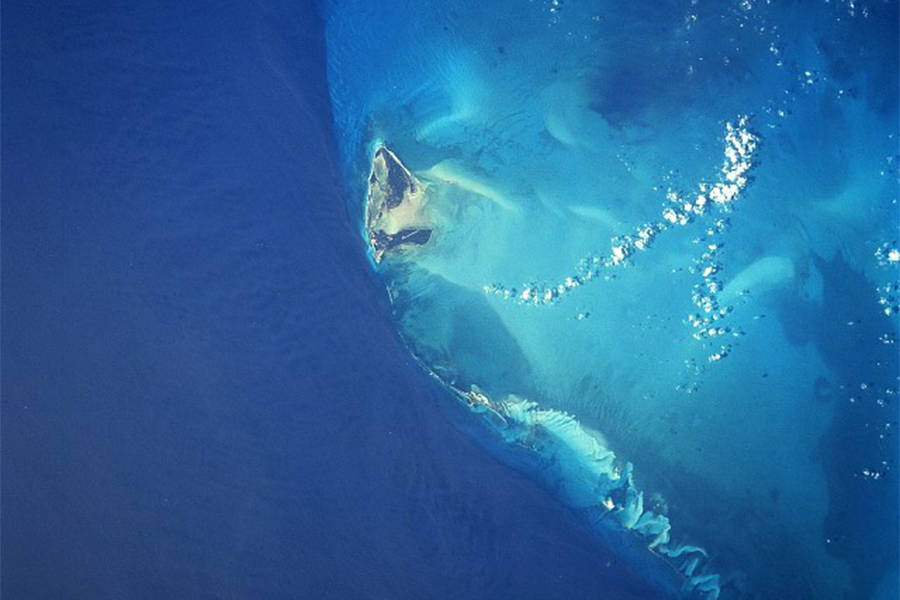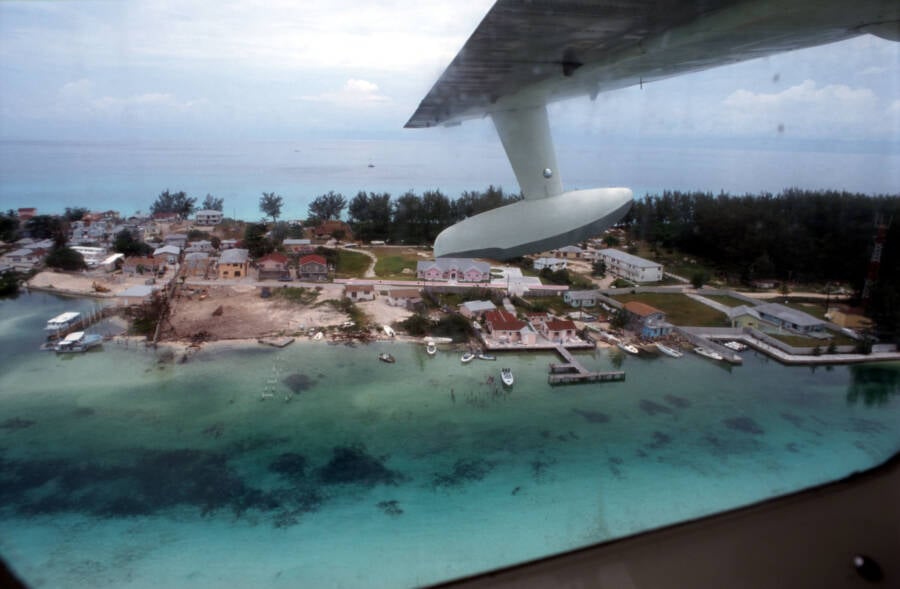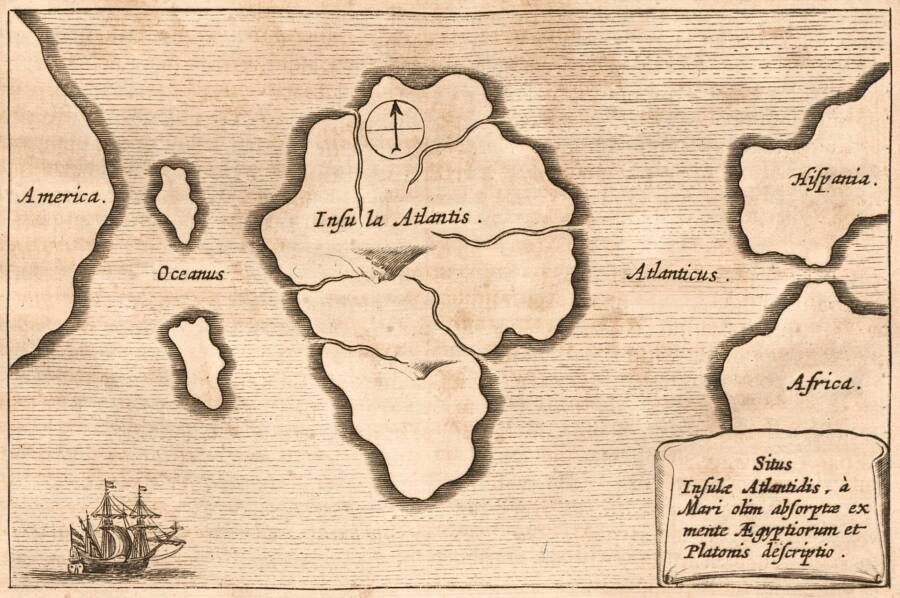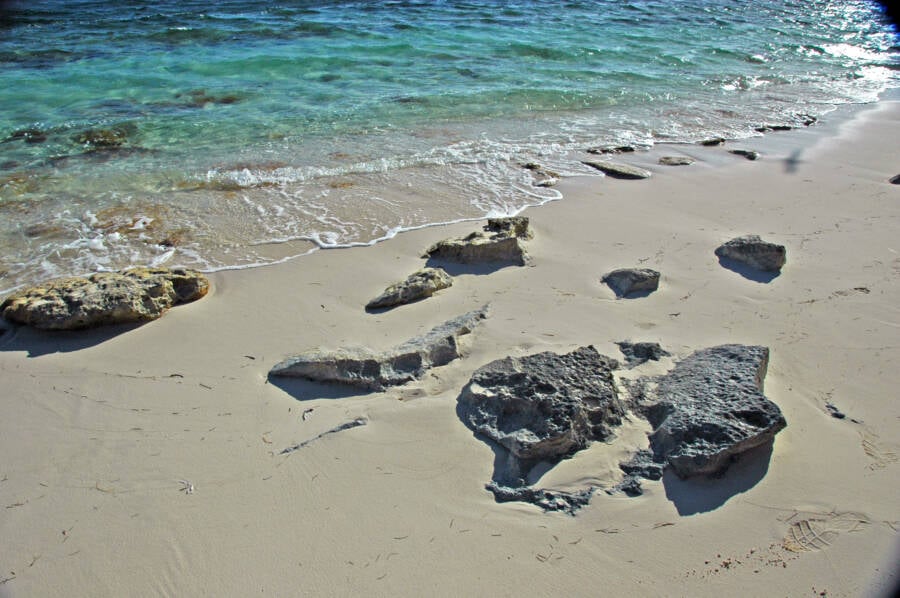Located off the coast of North Bimini island in the Bahamas, Bimini Road is a natural rock formation that looks like a cobblestone street on the ocean floor — leading some to believe that it once led to the sunken city of Atlantis.

New England Aquarium/YouTubeAn underwater view of the cobblestone-like rocks that make up Bimini Road.
While Atlantis may have first been mentioned by the ancient philosopher Plato, interest in “rediscovering” the fabled lost city only truly took off in the late 19th century. Since then, curious minds have attempted to identify the location of the sunken kingdom — and some have even turned to Bimini Road for potential answers.
But what is Bimini Road? Also known as Bimini Wall, it is an underwater rock formation near North Bimini island in the Bahamas composed of rectangular limestone blocks. It was discovered in 1968, and it has since sparked countless theories.
Some people have suggested it may have been a man-made wall, pier, or road, hence its name. However, scientists largely agree that the phenomenon formed naturally.
Still, that hasn’t stopped theorists who are convinced that Bimini Road was once a highway to Atlantis.
What Is Bimini Road?
Bimini Road was first discovered in September 1968 by Joseph Manson Valentine, Robert Angove, and Jacques Mayol. The men were diving in roughly 18 feet of water off the coast of North Bimini when they noticed a series of stones along the seafloor that almost looked as if they’d been placed there intentionally.

Public DomainNorth Bimini Island, where Bimini Road is located.
Set on a northeast-to-southwest line, the “road” runs nearly perfectly straight for 1,500 feet before ending in a curved hook. Alongside Bimini Road are two smaller linear rock formations that appear similar in design.
The discovery captured the attention of scholars, who sought to examine the newly dubbed Bimini Road in hopes of determining its origin. They found that the rock formation is made up of limestone blocks, most of which are vaguely rectangular in shape. At first glance, it could seem that the stones were intentionally cut with right angles that weathered over time.
Most of the blocks on the main road are between seven and 13 feet long, while the two other rock formations are made up of smaller stones. The larger blocks appear to line up with each other, and some of them even seem to be stacked as if they were propped up by hand.
The limestone that makes up Bimini Road is specifically known as beachrock, a mix of sand, gravel, and sediment like shells and coral fragments. But to the divers who initially discovered it, Bimini Road looked like “pavement.” They believed they were looking at one long, continuous rock, only to then learn that it was a number of smaller stones arranged in a linear formation.

Gratefldiver, Inc./Alamy Stock PhotoThe aquamarine coastline of Bimini.
Investigations into Bimini Road continued from there, with many researchers coming to the conclusion that it was a natural phenomenon. However, there were also those who saw the discovery of Bimini Road as evidence of Atlantis.
Had the Atlanteans constructed the road? Was it a highway into their ancient city? Could the road still lead to the sunken ruins of the once mighty nation?
These questions weren’t entirely without basis, however. Four decades before Bimini Road was discovered, a mystic named Edgar Cayce seemingly predicted its existence with chilling accuracy — and connected it to the fabled civilization.
Edgar Cayce’s Predictions About The Road To Atlantis
As geologist Eugene A. Shinn wrote in a 2004 article for the Skeptical Inquirer, Cayce was a mystic “healer” in the 1930s and ’40s. Known as the “Sleeping Prophet,” Cayce made a career out of performing psychic readings and making predictions.

Science History Images/Alamy Stock PhotoEdgar Cayce, an American psychic who claimed to have visions of Atlantis.
In 1938, Cayce reportedly predicted that Atlantean records for constructing mysterious energy crystals were located “in the sunken portions of Atlantis, where a portion of the temples may yet be discovered, under the slime of ages and sea water near Bimini… Expect it in ’68 or ’69 — not so far away.”
Of course, the discovery of Bimini Road came in 1968.
Once theorists linked Cayce’s claim with the discovery, believers in Atlantis flocked to the site. From there, further “evidence” came to light that, to some, pointed to the lost city. For starters, Bimini is in the Bermuda Triangle, which has long attracted its own paranormal theories and mysticism.

Public DomainA purported map of Atlantis, with south at the top of the map.
Shinn also described that Bimini Road had a certain “aura” to it, which some people call a “force field.” As he explained, by the time of the road’s discovery, Bimini was a popular drop point for drug smuggling. Back in Cayce’s time, it had been a popular spot for liquor smuggling. As a result, Bimini saw a large number of visitors who were there for less than savory reasons. One such visitor was Ernest Hemingway’s brother, Leicester, who claimed that he had found the Fountain of Youth on Bimini and that it had cured his cancer.
All this is to say that many legends have been linked to Bimini over the years. It was only natural, then, that Atlantis would be too. Interest — both paranormal and scholarly — had been piqued. Now, all that was left to do was dive down and see what Bimini Road had to offer.
What Researchers Learned When They Examined Bimini Road
Shinn was among a large wave of scientists who studied Bimini Road in the mid-1970s, though not all were quite as qualified. Among the researchers who visited Bimini Road were countless New Age thinkers, diviners, and people who believed Atlantis really did exist.
“A half dozen sailboats had already assembled at the site when we dropped anchor,” Shinn recalled of his trip to the site. “The people on the sailboats had dropped more than their anchors: they were all naked. One nude boater swam over and asked, ‘Can’t you feel the force field? It’s strong here.'”
Apparently, some New Age writers had claimed that nudity was a requirement for feeling whatever supposed energy was being emitted by Bimini Road’s stones.
Surrounded by naked swimmers, Shinn and his team began drilling down and removing bits and pieces of Bimini Road for analysis. This led to the discovery that the stones were made of beachrock, which forms rapidly beneath the sand on beaches. As ocean levels rise or beaches erode, the rock becomes submerged in the water and can break apart, giving it a cobblestone-like appearance.

James St. John/Wikimedia CommonsBeachrock emerging from the sand on San Salvador Island in the Bahamas.
This is the set of circumstances that led to the formation of Bimini Road. As Shinn noted, his team’s analysis revealed that “there were no artifacts, no wheel ruts, or any other evidence of an ancient civilization” and no signs that “the stones had been placed by humans.”
What’s more, radiocarbon dating of samples collected from Bimini Road also showed that the stones were between 2,000 and 4,000 years old. That doesn’t align with the purported age of Atlantis, which Plato claimed existed 10,000 years before he wrote Timaeus and Critias around 360 B.C.E. The location of Bimini Road doesn’t match Plato’s description of the sunken island, either, as he claimed Atlantis once stood in the Atlantic Ocean near the Strait of Gibraltar.
Of course, these scientific findings did little to sway the opinions of true believers, and mystics continued to peddle the idea that the Bimini Road may indeed pave the way to Atlantis.
After reading the bizarre story of Bimini Road, check out these 13 sunken cities around the world. Then, learn about Pig Beach, the island in the Bahamas inhabited by swimming swine.





